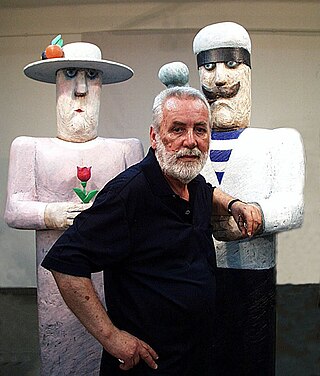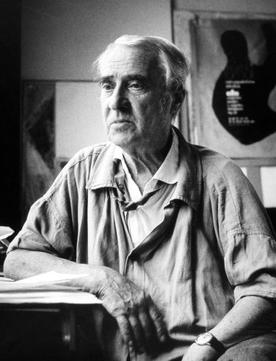Related Research Articles

The Meštrović Pavilion, also known as the Home of Croatian Artists and colloquially as the Mosque, is a cultural venue and the official seat of the Croatian Society of Fine Artists (HDLU) located on the Square of the Victims of Fascism in central Zagreb, Croatia. Designed by Ivan Meštrović and built in 1938, it has served several functions in its lifetime. An art gallery before World War II, it was converted into a mosque under the Independent State of Croatia and was subsequently transformed into the Museum of the Revolution in post-war Yugoslavia. In 1990, it was given back to the Croatian Association of Artists. After extensive renovation, it has served as a space for exhibitions and events since 2006.

Antun Augustinčić was a Croatian sculptor active in Yugoslavia and the United States. Along with Ivan Meštrović and Frano Kršinić he is considered one of the three most important Croatian sculptors of the 20th century. His most notable sculptures include the Peace monument which stands in front of the United Nations building in New York City, the Miner statue in front of the International Labour Organization headquarters in Geneva, and the sculpture of Yugoslav president Josip Broz Tito, present in several copies throughout former Yugoslavia.
The Vladimir Nazor Award is a Croatian prize for arts and culture established in 1959 and awarded every year by the Ministry of Culture.

The Art pavilion in Zagreb is an art gallery in Zagreb, Croatia. The pavilion is located on the Lenuci Horseshoe, Lower town area of the city, south of Nikola Šubić Zrinski Square, on the northern side of the King Tomislav Square which flanks the Zagreb Central Station. Established in 1898, it is the oldest gallery in the Southeast Europe and the only purpose-built gallery in Zagreb designed specifically to accommodate large scale exhibitions.

Vasko Lipovac was a Yugoslavian and Croatian painter, sculptor, printmaker, designer, illustrator and scenographer and one of the most prominent artists of the region. He is best known for his minimalist figuration and use of intense, unmodulated and often dissonant palette. With the exception of his juvenile period of geometric abstraction, he remained loyal to figuration throughout his whole career. Exceptionally prolific, he worked in various techniques and was equally skilful in using high-polished metal, polychromous wood, enamel, terracotta or polyester to create his sculptures, reliefs and mobiles.
Dimitrije Popović is an eminent Montenegrin and Croatian painter, sculptor, art critic and philosopher born in Cetinje, Montenegro. He attended elementary and high school in his hometown and graduated from the Academy of Fine Arts in Zagreb in 1976 in the class of professor Šime Perić.

Croatian art of the 20th century, that is visual arts within the boundaries of today's Croatia, can be divided into modern art up to the Second World War, and contemporary art afterwards.
Krsto Hegedušić was a Croatian painter, illustrator and theater designer. His most famous paintings depict the harsh life of the Croatian peasantry in the manner of naive art. He was one of the founders of the Earth Group.

Modern Gallery is a museum in Zagreb, Croatia that holds the most important and comprehensive collection of paintings, sculptures and drawings by 19th and 20th century Croatian artists. The collection numbers around 10,000 works of art, housed since 1934 in the historic Vranyczany Palace in the centre of Zagreb, overlooking the Zrinjevac Park. A secondary gallery is the Josip Račić Studio at Margaretska 3.

Menci Clement Crnčić was a Croatian painter, printmaker, teacher and museum director. He studied painting and drawing in Vienna and Munich, and trained in graphic arts in Vienna, studying etching and engraving. He was the first artist in the Croatian graphic tradition to abandon a strictly linear style and use tonal variation to create contrasting areas of light and shade.
Lavoslav Horvat was a Croatian architect.

Emanuel Božidar Vidović was a Croatian painter and graphic artist from Split.

Marino Tartaglia was a Croatian painter and art teacher, for many years a professor at the Academy of Fine Arts, Zagreb.
Zlatko Šulentić was a Croatian painter of landscapes and portraits.
Vladimir Varlaj was a Croatian artist, a member of the Group of Four during the Zagreb Spring Salon of the 1920s, and a founder of the Independent Group of Artists. He was influential in the Zagreb modern art scene of the 1920s and 1930s, best known for his landscape paintings and his contribution in bringing wider European influences to Croatian art.
Oton Postružnik (1900–1978) was a Croatian artist, painter, graphic artist, and ceramist. He was one of the founding members of the Earth Group artist collective in Zagreb from 1929 to 1933. He studied in Zagreb, Prague and Paris, and was a professor at the Academy of Fine Arts in Zagreb from 1950 to 1970. He is best known for his abstract paintings of natural subjects, such as his Leaf series.
Edo Kovačević was a Croatian artist, best known for his colourful landscapes and views of suburban Zagreb. He worked mainly in oils and pastels, using subtle colour harmonies and lively brush strokes to bring out the natural beauty of ordinary subjects. Kovačević also designed theatrical stage sets for the Croatian National Theatre, the Drama Theatre and the Puppet Theatre, for many years, taught art at the Zagreb School of Crafts, and organized art exhibitions and installations.

The art of Yugoslavia is the visual art created by a number of painters, sculptors and graphics artists in Yugoslavia.
Leo (Leopold) Junek was a Croatian–French painter. He was a founding member of the Group Zemlja, one of the most influential movements in the history of Croatian art. He studied at the Zagreb Academy of Fine Arts, and subsequently moved to France, where he spent the rest of his life and was known as Lorris Junec. He is remembered for his sharp, geometric, colourful landscapes inspired by Post-Impressionism, Cubism, Fauvism, and Dada.
References
- ↑ Bilić, Josip; Ivanković, Hrvoje, eds. (2006). "Zemlja". Zagrebački leksikon (in Croatian). Zagreb: Miroslav Krleža Institute of Lexicography and Masmedia. ISBN 953-157-486-3.